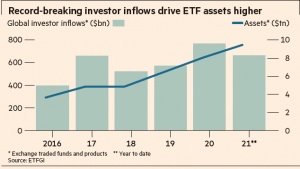
Model portfolios and ESG lead charge amid strong rebound in asset prices from pandemic low
MICHAEL MACKENZIE AND CHRIS FLOOD

Investors are pouring money into exchange traded funds at a historic pace as equity and corporate bond markets rally to new peaks and asset managers increasingly turn to the vehicles to build portfolios.
Flows into ETFs are already on track to outpace a record 2020, totalling $659bn in the first six months of 2021 compared with $767bn for all of last year, according to ETFGI.
Global equity-based ETFs have already eclipsed last year’s intake, attracting net flows of $459bn as of June 30, exceeding $366bn and $283bn for 2020 and 2019, respectively.
The boom reflects a strong rebound in asset prices from their pandemic lows of 2020 but it also shows how fund managers are using ETFs as an important instrument in portfolios, in some cases replacing or being used in conjunction with individual securities.
Already a $9tn global market, the swift growth of the ETF universe is feeding a bullish view among big players, led by companies such as BlackRock, State Street and Invesco.
“It took 15 years for iShares to reach $1tn in assets, five years more to hit $2tn and just two more years to pass the $3tn mark,” said Salim Ramji, global head of iShares and index investments at BlackRock. The asset manager expects the global market will expand to $15tn by 2025.
BlackRock’s iShares unit attracted net inflows of $75bn in the second quarter of this year and exceeded $3tn in assets in June, the group said on Wednesday.
The quarterly flows were up from $51bn a year ago and accounted for the bulk of the asset manager’s overall inflows of $81bn for the recent three-month period.
Hot areas of long-term growth include expanding investor activity in fixed income, a growing preference for model portfolios — such as those targeting 60 per cent stocks and 40 per cent bonds — by wealth advisers and also from the increasing popularity of mandates that take into account environmental, social and corporate governance standards.
Among a number of growth drivers, traditional stock pickers that aim to buy companies that will beat the broader market’s performance are increasing their use of ETFs in actively managed portfolios.
“Asset managers have found a way to participate in ETFs that provides them with the ability to use their stockpicking and portfolio construction expertise,” said Todd Rosenbluth, head of mutual fund and ETF research at CFRA. “Adoption is accelerating with insurance companies and other institutional investors.”
Assets held in the US model portfolio market will more than double from $4tn over the next five years to $10tn, according to BlackRock.
It expects half of the new investor inflow for its US ETF arm to come from model portfolios in the future, up from about a third in 2020.
State Street, the third-largest ETF provider globally, is also expanding its model portfolios business.
“We are working on building partnerships with other providers as well as offering model portfolios, which we have developed in-house,” said Rory Tobin, global head of ETFs at State Street Global Advisors.
It teamed up with Natixis, the French asset manager, to offer model portfolios to US financial advisers via Bank of America’s platform in late 2019.
Bond ETFs have taken in new client money at a slower rate than their equities peers this year.
Inflows have clocked in at $112bn in 2021 compared with $231bn for all of 2021, ETFGI data show.
“Fixed income is 10 years behind equities in their respective ETF life cycles,” said Jason Bloom, head of fixed income and alternatives ETF strategy at Invesco.
Before the launch of new ETFs, areas in fixed income including asset-backed securities and bank loans were not easily accessible for retail investors and even financial advisers, said Bloom. “You now have access to parts of the fixed income markets that you didn’t have before.”
Bond ETFs emerged from the pandemic crash in March of 2020 with a reputation of having passed a stress test.
A decision by the US Federal Reserve to buy ETFs tracking corporate bonds also played an important role in easing market turmoil and investor concerns about the product.
However, Craig Siegenthaler, senior equity research analyst at Credit Suisse, noted that, if the benign market environment turns choppier, ETF providers could struggle to continue growing at such a swift pace.
“Most of the investment community is bullish on ETFs and fixed income is seen getting much bigger but, if we get a bear market, that will make it tougher for the industry to keep growing at the pace we have seen,” he said.
Fonte: Financial Time del 16/07/2021

